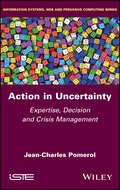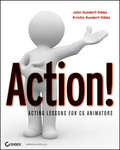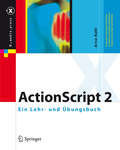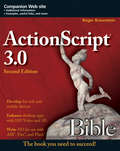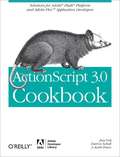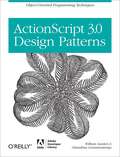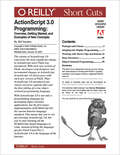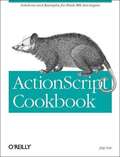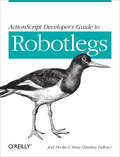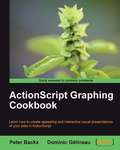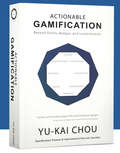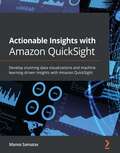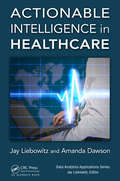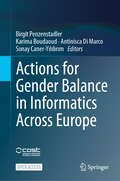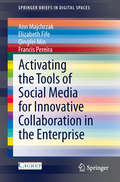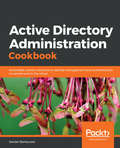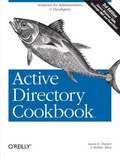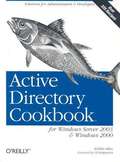- Table View
- List View
Action in Uncertainty: Expertise, Decision and Crisis Management
by Jean-Charles PomerolDespite uncertainty, people are born to act. Faced with environmental aggression and upheaval, inaction is more stressful than action. What choices, strategies or methods need to be implemented so that action is as effective as possible in terms of the objectives to be achieved? We should not delude ourselves about the term "good decision", which does not have much meaning when we act in an uncertain environment and when we know the weakness of forecasts. However, we must know how to act and be capable of taking the most appropriate action. Action in Uncertainty is a real guide to taking effective action when nothing is certain. According to the different types of uncertainty, what are the respective good uses of expertise and intuition? How do we motivate teams and avoid cognitive bias and manipulation? These themes are dealt with in clear and accessible terms to help decision-makers make the right choices in a world that is more uncertain than ever.
Action!
by Kristin Kundert-Gibbs John Kundert-GibbsIn order to bring a character to life, it is beneficial for animators to have a solid understanding of acting principles, and this book examines the important skills behind the artistry of creating animated characters. With a particular emphasis on a character's motions and movement, this unique resource covers the basic elements of acting for CG animation and then progresses to more advanced topics such as internal intent and motivation.Note: CD-ROM/DVD and other supplementary materials are not included as part of eBook file.
ActionScript 2: Ein Lehr- und Übungsbuch (X.media.press)
by Arno KohlFlash und ActionScript sind aus der Gestaltung interaktiver Websites nicht mehr wegzudenken. Autor Arno Kohl von der "Macromedia Akademie für Medien", ist Experte auf dem Gebiet. In Teil 1: Programmierkonzepte sowie die Strukturen der Scriptsprache ActionScript (AS) anhand praktischer Übungsbeispiele. In Teil 2: Workshops zur Erstellung einer Website inkl. spezifischer Elemente - komplexe Preloader, gescriptete (Animations-)Effekte, XML generierte dynamische Menüs, modularer Aufbau mit swf, Bildgalerie, Templates, Spiele, Komponenten. Wer Grundkenntnisse in Actionscripting besitzt, kann die Workshops (auf CD-ROM) schrittweise nachvollziehen.
ActionScript 3.0 Bible (Bible #617)
by Roger BraunsteinThe updated edition on all the latest features and capabilities of ActionScript 3.0 and Flash Player 10. ActionScript is a popular programming language used primarily for the development of Web sites and software. This update to the successful previous version introduces you to all the exciting new capabilities of ActionScript 3.0. You'll see how ActionScript 3.0 goes beyond its primary use of scripting Flash animations and is now an object-oriented evolution that runs ten times faster than previous versions and can be used in Adobe's new platforms, including Flex and AIR. Hands-on instruction and step-by-step tutorials enhance your learning process as you discover everything you need to know in order to harness the power of ActionScript 3.0. You'll learn the nitty gritty of building Rich Internet Applications (RIA) and the ins and outs of putting the new features of ActionScript 3.0 to work for you. ActionScript 3.0 goes beyond its original role as a scripting language and has added development features, incredible speed, and the ability to work with Flex and AIR Shows you how to apply advanced graphic effects using Pixel Blender Demonstrates the all-new text and typography capabilities Addresses your new enhanced control over dynamic sound Explains templated types and new vector data structures ActionScript 3.0 Bible offers you a soup-to-nuts guide on all things ActionScript 3.0 so you can get started working with it immediately.
ActionScript 3.0 Cookbook: Solutions for Flash Platform and Flex Application Developers
by Joey Lott Darron Schall Keith PetersWell before Ajax and Microsoft's Windows Presentation Foundation hit the scene, Macromedia offered the first method for building web pages with the responsiveness and functionality of desktop programs with its Flash-based "Rich Internet Applications". Now, new owner Adobe is taking Flash and its powerful capabilities beyond the Web and making it a full-fledged development environment.Rather than focus on theory, the ActionScript 3.0 Cookbook concentrates on the practical application of ActionScript, with more than 300 solutions you can use to solve a wide range of common coding dilemmas. You'll find recipes that show you how to:Detect the user's Flash Player version or their operating systemBuild custom classesFormat dates and currency typesWork with stringsBuild user interface componentsWork with audio and videoMake remote procedure calls using Flash Remoting and web servicesLoad, send, and search XML dataAnd much, much more ...Each code recipe presents the Problem, Solution, and Discussion of how you can use it in other ways or personalize it for your own needs, and why it works. You can quickly locate the recipe that most closely matches your situation and get the solution without reading the whole book to understand the underlying code. Solutions progress from short recipes for small problems to more complex scripts for thornier riddles, and the discussions offer a deeper analysis for resolving similar issues in the future, along with possible design choices and ramifications. You'll even learn how to link modular ActionScript pieces together to create rock-solid solutions for Flex 2 and Flash applications.When you're not sure how ActionScript 3.0 works or how to approach a specific programming dilemma, you can simply pick up the book, flip to the relevant recipe(s), and quickly find the solution you're looking for.Adobe Developer Library is a co-publishing partnership between O'Reilly Media and Adobe Systems, Inc. and is designed to produce the number one information resources for developers who use Adobe technologies. Created in 2006, the Adobe Developer Library is the official source for comprehensive learning solutions to help developers create expressive and interactive web applications that can reach virtually anyone on any platform. With top-notch books and innovative online resources covering the latest in rich Internet application development, the Adobe Developer Library offers expert training and in-depth resources, straight from the source.
ActionScript 3.0 Design Patterns
by Chandima Cumaranatunge William SandersNow that ActionScript is reengineered from top to bottom as a true object-oriented programming (OOP) language, reusable design patterns are an ideal way to solve common problems in Flash and Flex applications. If you're an experienced Flash or Flex developer ready to tackle sophisticated programming techniques with ActionScript 3.0, this hands-on introduction to design patterns is the book you need.ActionScript 3.0 Design Patterns takes you step by step through the process, first by explaining how design patterns provide a clear road map for structuring code that actually makes OOP languages easier to learn and use. You then learn about various types of design patterns and construct small abstract examples before trying your hand at building full-fledged working applications outlined in the book. Topics in ActionScript 3.0 Design Patterns include: Key features of ActionScript 3.0 and why it became an OOP language OOP characteristics, such as classes, abstraction, inheritance, and polymorphism The benefits of using design patterns Creational patterns, including Factory and Singleton patterns Structural patterns, including Decorator, Adapter, and Composite patterns Behavioral patterns, including Command, Observer, Strategy, and State patterns Multiple design patterns, including Model-View-Controller and Symmetric Proxy designs During the course of the book, you'll work with examples of increasing complexity, such as an e-business application with service options that users can select, an interface for selecting a class of products and individual products in each class, an action game application, a video record and playback application, and many more. Whether you're coming to Flash and Flex from Java or C++, or have experience with ActionScript 2.0, ActionScript 3.0 Design Patterns will have you constructing truly elegant solutions for your Flash and Flex applications in no time.
ActionScript 3.0 Programming: Overview, Getting Started, and Examples of New Concepts
by William SandersActionScript 3.0 Programming: Overview, Getting Started, and Examples of New Concepts is a 76-page document designed to introduce those familiar with general programming principles to ActionScript 3.0. ActionScript 3.0 compiles and runs much faster than preceding versions, and the reasons have much to do with the structural changes Adobe has added: You truly do need to use ActionScript differently than you have previously, if you're already ActionScript programmer. If you're new to ActionScript, but are looking at it from a Java or C++ or C# perspective, you may be intrigued at how different ActionScript is now compared with what you'd known it or heard it to be before.This document employs reusable code examples to demonstrate the basic functionality of ActionScript 3.0 in the following topic areas: Packages and Classes; Display Programming; Movie Clips and Buttons; and Basic Structures. A concluding section helps those unfamiliar with OOP (Object Oriented Programming) and Design Patterns get acquainted with these concepts, as a knowledge of them will greatly benefit anyone getting into ActionScript 3.0 who wants to get the most out of it.
ActionScript Cookbook
by Joey LottActionScript's sheer volume of capabilities can be daunting. The ActionScript Cookbook breaks it all down into tasks that are relevant, practical, and insightful. On top of hundreds of atomic recipes, it offers seven full chapters of larger sample applications. Appealing to all levels of ActionScript coders, this book offers concrete solutions to the most common ActionScript needs and problems. The ActionScript Cookbook is for people who want to hit the ground running.
ActionScript Developer's Guide to PureMVC: Code at the Speed of Thought
by Cliff HallGain hands-on experience with PureMVC, the popular open source framework for developing maintainable applications with a Model-View-Controller architecture. In this concise guide, PureMVC creator Cliff Hall teaches the fundamentals of PureMVC development by walking you through the construction of a complete non-trivial Adobe AIR application.Through clear explanations and numerous ActionScript code examples, you’ll learn best practices for using the framework’s classes in your day-to-day work. Discover how PureMVC enables you to focus on the purpose and scope of your application, while the framework takes care of the plumbing in a maintainable and portable way.Get a detailed overview of the PureMVC process for developing your applicationModel the domain by designing the schema and creating framework-agnostic value objectsImplement framework-agnostic View components that expose an API of events and propertiesUse the Proxy pattern to keep track of value objects and hide service interactionFacilitate two-way communication between a View component and the rest of the applicationStitch the Model and View tiers together with command objects in the ControllerManage problematic View component life cycles, and learn how to reuse the Model tier
ActionScript Developer's Guide to Robotlegs: Building Flexible Rich Internet Applications (Oreilly And Associate Ser.)
by Joel Hooks StrayRobotlegs is a standout among the ActionScript 3 development frameworks available today. With it, Flash, Flex, and AIR developers can create well-architected, testable, and flexible Rich Internet Applications—fast. This concise guide shows you how the light footprint and focused scope of this open source framework not only solves your immediate coding problems, it helps you gain insight into AS3 architecture on a much deeper level.The authors provide a walkthrough of specific features in two applications they've written in Robotlegs, complete with code for each application as a whole. You'll learn how to achieve a balance of flexibility and consistency in your own projects.Solve 80% of your coding problems with 20% of the APIGain code-base flexibility with automated Dependency InjectionLearn the anatomy of a Robotlegs applicationUnderstand the relationships between models, services, control code, and views in the framework's MVCS architectureSee how the Robotlegs’ approach facilitates Test Driven Development (TDD)Pick up practical methods for architecting Robotlegs solutionsGet expert insights to power-up your existing Robotlegs code
ActionScript Graphing Cookbook
by Dominic Gélineau Peter BackxStep-by-step instructions guide you from your very first graphical program to highly complex 3D presentations. Although a few recipes explain charts in Flex, this book is firmly focussed on using ActionScript code and data to draw graphs. The "ActionScript Graphing Cookbook" is aimed at any ActionScript developer who wants to add data visualization to their skill set. The reader should be familiar with ActionScript basics, but no deep knowledge of any graphical functions is required.
ActionScript for Flash MX: The Definitive Guide, 2nd Edition
by Colin MoockActionScript for Flash MX: The Definitive Guide is the most complete, up-to-date reference available for the latest version of ActionScript. Author Colin Moock has added hundreds of new code examples to show new Flash MX techniques in the real world. The book's language reference alone has nearly doubled from the first edition, with more than 250 new classes, objects, methods, and properties. You'll find exhaustive coverage of dozens of undocumented, under-documented, and mis-documented features.
ActionScript for Flash MX: The Definitive Guide, 2nd Edition
by Colin MoockUpdated to cover Flash MX, the newest version of Macromedia Flash, ActionScript for Flash MX: The Definitive Guide , Second Edition is the one book no serious Flash developer should be without. ActionScript is Macromedia's programming language for Flash MX, the popular authoring tool for creating rich internet applications and animations for the Web. With Macromedia's new focus on application development, ActionScript now includes a direct drawing API, loading of external MP3 and JPG files, improved sound control, an extensive set of text formatting tools, complete support for component development using movie clip subclasses, local data storage, accessibility features, and much more. And ActionScript for Flash MX: The Definitive Guide is the most complete, up-to-date reference available for the latest version of this language. Author Colin Moock, one of the most universally respected developers in the Flash community, has added hundreds of new code examples to show new Flash MX techniques in the real world: how to draw circles, save data to disk, convert arrays to onscreen tables, create reusable components, and preload variables, XML, and sounds. The book's language reference alone has nearly doubled from the first edition, with more than 250 new classes, objects, methods, and properties. You'll find exhaustive coverage of dozens of undocumented, under-documented, and mis-documented features. Along with the new material, Colin Moock has meticulously revised the entire text to conform to Flash MX best-coding practices. In particular, objected-oriented programming and the new event model get special attention in light of changes to Flash MX ActionScript. From sending data between two movies to creating getter/setter properties, the new edition of this book demystifies the often-confusing new features of Flash MX, giving developers easy access to its powerful new capabilities. ActionScript for Flash MX: The Definitive Guide is structured so non-programmers can learn how to use ActionScript and programmers can take their skills to new heights. If you are in the market to really learn about the hows and whys of ActionScript, then this is the book for you.
ActionScript: The Definitive Guide
by Colin MoockGiven its ability to deliver high-impact experiences even over low-bandwidth connections, Flash has become the de facto standard for hundreds of thousands of multimedia web developers worldwide. Flash 5 now includes a new full-fledged programming language called "ActionScript" for controlling animation and multimedia. It's a quantum leap from the bare-bones "Actions" supported in Flash 4, and ActionScript: The Definitive Guide is the first book dedicated entirely to documenting and demonstrating this new language. ActionScript includes all fundamental programming constructs (variables, loops, conditionals, functions, etc.), and is inextricably fused with Flash's authoring behaviors and animation timelines. Because ActionScript is based heavily on the ECMAScript Language Specification (ECMA-262) and is syntactically nearly identical to JavaScript, Macromedia expects thousands of existing JavaScript programmers to migrate to ActionScript. This book is divided into three sections. "ActionScript Fundamentals" introduces both programmers and non-programmers to the new language by first describing fundamental programming concepts and then delineating in detail the components, syntax, and usage of ActionScript. "Applied ActionScript Code Depot" shows you how to use common applications, such as processing online forms. "Language Reference" is a concise and detailed reference that makes all ActionScript globals, properties, and objects, including extensive implementation samples, easy to find quickly. Step-by-step tutorials of the most common ActionScript behaviors Object-oriented programming in Flash Intelligent interface development Server communication Dynamic content generation Password protection String handling Message boards Basic physics Games Code samples are also available from the "Code Depot" on the author's web site devoted to Flash developers. Topics covered in this book include: ActionScript: The Definitive Guide is structured so both programmers and non-programmers can learn how to use ActionScript. This book will take you well beyond simple Flash animations so you can create your own enhanced Flash-driven sites.
Actionable Gamification: Beyond Points, Badges, and Leaderboards
by Yu-kai ChouLearn all about implementing a good gamification design into your products, workplace, and lifestyle Key Features • Explore what makes a game fun and engaging • Gain insight into the Octalysis Framework and its applications • Discover the potential of the Core Drives of gamification through real-world scenarios Book Description Effective gamification is a combination of game design, game dynamics, user experience, and ROI-driving business implementations. This book explores the interplay between these disciplines and captures the core principles that contribute to a good gamification design. The book starts with an overview of the Octalysis Framework and the 8 Core Drives that can be used to build strategies around the various systems that make games engaging. As the book progresses, each chapter delves deep into a Core Drive, explaining its design and how it should be used. Finally, to apply all the concepts and techniques that you learn throughout, the book contains a brief showcase of using the Octalysis Framework to design a project experience from scratch. After reading this book, you'll have the knowledge and skills to enable the widespread adoption of good gamification and human-focused design in all types of industries. What you will learn • Discover ways to use gamification techniques in real-world situations • Design fun, engaging, and rewarding experiences with Octalysis • Understand what gamification means and how to categorize it • Leverage the power of different Core Drives in your applications • Explore how Left Brain and Right Brain Core Drives differ in motivation and design methodologies • Examine the fascinating intricacies of White Hat and Black Hat Core Drives Who this book is for Anyone who wants to implement gamification principles and techniques into their products, workplace, and lifestyle will find this book useful.
Actionable Insights with Amazon QuickSight: Develop stunning data visualizations and machine learning-driven insights with Amazon QuickSight
by Manos SamatasBuild interactive dashboards and storytelling reports at scale with the cloud-native BI tool - Amazon QuickSight, including embedded analytics and ML-powered insightsKey FeaturesUnderstand how to set up Amazon QuickSight, manage data sources, and build and share dashboardsLearn the advanced features of Amazon Quicksight to develop interactive and embedded dashboardsManage and monitor dashboards using the QuickSight API and other AWS services such as Amazon CloudTrailBook DescriptionThe adoption of cloud-native BI tools, like Amazon QuickSight, enables organizations to gather insights from data at scale. This book is a practical guide to performing simple-to-advanced tasks with Amazon QuickSight.You'll begin by learning QuickSight's fundamental concepts and how to configure data sources. Next, you'll be introduced to the main analysis-building functionality of QuickSight to develop visuals and dashboards. The book will also demonstrate how to develop and share interactive dashboards with parameters and on-screen controls. Advanced filtering options with URL actions will then be covered, before learning how to set up alerts and scheduled reports. Later, you'll explore the Insights visual type in QuickSight using both existing insights and by building custom insights. Further chapters will show you how to add machine learning insights such as forecasting capabilities, analyzing time series data, adding narratives, and outlier detection to your dashboards. You'll also explore patterns to automate operations and look closer into the API actions that allow us to control settings. Finally, you'll learn advanced topics such as embedded dashboards and multitenancy.By the end of this book, you'll be well-versed with QuickSight's BI and analytics functionalities that will help you create BI apps with ML capabilities.What you will learnUnderstand the wider AWS analytics ecosystem and how QuickSight fits within itSet up and configure data sources with Amazon QuickSightInclude custom controls and add interactivity to your BI application using parametersAdd ML insights such as forecasting, anomaly detection, and narrativesExplore patterns to automate operations using QuickSight APIsCreate interactive dashboards and storytelling with Amazon QuickSightDesign an embedded multi-tenant analytics architectureFocus on data permissions and how to manage Amazon QuickSight operationsWho this book is forThis book is for business intelligence (BI) developers and data analysts who are looking to create interactive dashboards using data from Lake House on AWS with Amazon QuickSight. This book will also be useful for anyone who wants to learn Amazon QuickSight in depth using practical examples. You will need to be familiar with general data visualization concepts, however, no prior experience with Amazon QuickSight is required.
Actionable Intelligence in Healthcare (Data Analytics Applications)
by Amanda Dawson Jay LiebowitzThis book shows healthcare professionals how to turn data points into meaningful knowledge upon which they can take effective action. Actionable intelligence can take many forms, from informing health policymakers on effective strategies for the population to providing direct and predictive insights on patients to healthcare providers so they can achieve positive outcomes. It can assist those performing clinical research where relevant statistical methods are applied to both identify the efficacy of treatments and improve clinical trial design. It also benefits healthcare data standards groups through which pertinent data governance policies are implemented to ensure quality data are obtained, measured, and evaluated for the benefit of all involved. Although the obvious constant thread among all of these important healthcare use cases of actionable intelligence is the data at hand, such data in and of itself merely represents one element of the full structure of healthcare data analytics. This book examines the structure for turning data into actionable knowledge and discusses: The importance of establishing research questions Data collection policies and data governance Principle-centered data analytics to transform data into information Understanding the "why" of classified causes and effects Narratives and visualizations to inform all interested parties Actionable Intelligence in Healthcare is an important examination of how proper healthcare-related questions should be formulated, how relevant data must be transformed to associated information, and how the processing of information relates to knowledge. It indicates to clinicians and researchers why this relative knowledge is meaningful and how best to apply such newfound understanding for the betterment of all.
Actions for Gender Balance in Informatics Across Europe
by Antinisca Di Marco Birgit Penzenstadler Karima Boudaoud Sonay Caner-YıldırımThis book is a open access. The primary purpose of this book is to serve as a comprehensive guide, translating research into best practices to promote gender inclusivity in informatics. The handbook seeks to empower its readers, providing them with actionable recommendations to bridge the gender gap in informatics. This initiative aims to have an immediate impact on the informatics community, raising awareness and interest through its practical resources, and on the society bringing more women into computer science and technological studies and following career steps. This book provides you with five years of research on gender equity and improving the gender balance in Informatics across Europe. It translates current research on gender inclusivity into practical strategies and intervention methods. It offers recommendations for the recruitment, retention, and promotion of female computer scientists at different academic and industrial levels, and insights into fostering mutually beneficial cooperation between universities and industries. We have collected data from different target audiences and different education and career levels to provide insights into why we have low girl and women participation rates in sciences, why we have a leaky pipeline in academia, and why women leave the industry. We have analyzed this data and identified four target audiences for activities and policy influence. We provide sets of recommendations for each of these target groups on how to become active in advocacy as well as specific actions in their daily environments to improve learning and work environments as well as retention of women students and personnel. We provide ample scenarios of how to apply our findings in practice and share materials both in the book as well as in free public access online documentation to further disseminate and make use of this knowledge. The book serves as joint European voice of Informatics to increase the equity for women in the field.
Activating the Tools of Social Media for Innovative Collaboration in the Enterprise (SpringerBriefs in Digital Spaces)
by Ann Majchrzak Elizabeth Fife Qingfei Min Francis PereiraThe use of social media tools in the enterprise is expanding rapidly and yet, firms are still unclear about the overall value of this activity and how best to facilitate useful outcomes. The focus of this book is, from a managerial standpoint, the control of information, the extent to which such tools can enhance employee satisfaction and how best to use social media tools to attain specific outcomes including innovative collaboration. As companies turn to IT solutions as substitutes for face-to-face engagements, an understanding of the social dynamics - how employees can best communicate, find and use information and generate motivation through computer-mediated activities is fundamental. Lingering questions relate to the strategic use of these tools; many large companies are using Facebook-like applications due to employee demand, but are not studying outcomes comprehensively or managing processes to create desired outcomes. This book fills this knowledge gap through examining the process and results of a controlled study in two companies, one in the US and the other in China. In each company "wiki challenges" were introduced to employees who were provided guidelines to produce goal-oriented outcomes. The book examine the results in each case and suggest guidelines for firms to achieve "wiki-readiness" to support innovation and co-creation.
Active Directory
by Alistair G. Lowe-Norris Robbie Allen Joe RichardsWorking with Microsoft's network directory service for the first time can be a headache for system and network administrators, IT professionals, technical project managers, and programmers alike. This authoritative guide is meant to relieve that pain. Instead of going through the graphical user interface screen by screen, O'Reilly's bestselling Active Directory tells you how to design, manage, and maintain a small, medium, or enterprise Active Directory infrastructure.Fully updated to cover Active Directory for Windows Server 2003 SP1 and R2, this third edition is full of important updates and corrections. It's perfect for all Active Directory administrators, whether you manage a single server or a global multinational with thousands of servers. Active Directory, 3rd Edition is divided into three parts. Part I introduces much of how Active Directory works, giving you a thorough grounding in its concepts. Some of the topics include Active Directory replication, the schema, application partitions, group policies, and interaction with DNS. Part II details the issues around properly designing the directory infrastructure. Topics include designing the namespace, creating a site topology, designing group policies for locking down client settings, auditing, permissions, backup and recovery, and a look at Microsoft's future direction with Directory Services. Part III covers how to create and manipulate users, groups, printers, and other objects that you may need in your everyday management of Active Directory. If you want a book that lays bare the design and management of an enterprise or departmental Active Directory, then look no further. Active Directory, 3rd Edition will quickly earn its place among the books you don't want to be without.
Active Directory Administration Cookbook: Actionable, proven solutions to identity management and authentication on servers and in the cloud
by Sander BerkouwerLearn the intricacies of managing Azure AD, Azure AD Connect as well as Active Directory for administration on cloud and Windows Server 2019Key FeaturesExpert solutions for the federation, certificates, security, and monitoring with Active DirectoryExplore Azure AD and AD Connect for effective administration on cloudAutomate security tasks using Active Directory and PowerShellBook DescriptionActive Directory is an administration system for Windows administrators to automate network, security and access management tasks in the Windows infrastructure.This book starts off with a detailed focus on forests, domains, trusts, schemas and partitions. Next, you learn how to manage domain controllers, organizational units and the default containers. Going forward, you deep dive into managing Active Directory sites as well as identifying and solving replication problems. The next set of chapters covers the different components of Active Directory and discusses the management of users, groups and computers. You also go through recipes that help you manage your Active Directory domains, manage user and groups objects and computer accounts, expiring group memberships and group Managed Service Accounts with PowerShell. You learn how to work with Group Policy and how to get the most out of it. The last set of chapters covers federation, security and monitoring. You will also learn about Azure Active Directory and how to integrate on-premises Active Directory with Azure AD. You learn how Azure AD Connect synchronization works, which will help you manage Azure AD.By the end of the book, you have learned in detail about Active Directory and Azure AD, too.What you will learnManage new Active Directory features, such as the Recycle Bin, group Managed Service Accounts, and fine-grained password policiesWork with Active Directory from the command line and use Windows PowerShell to automate tasksCreate and remove forests, domains, and trustsCreate groups, modify group scope and type, and manage membershipsDelegate control, view and modify permissionsOptimize Active Directory and Azure AD in terms of securityWho this book is forThis book will cater to administrators of existing Active Directory Domain Services environments and/or Azure AD tenants, looking for guidance to optimize their day-to-day effectiveness. Basic networking and Windows Server Operating System knowledge would come in handy.
Active Directory Administration Cookbook: Proven solutions to everyday identity and authentication challenges for both on-premises and the cloud, 2nd Edition
by Sander BerkouwerSimplified actionable recipes for managing Active Directory and Azure AD, as well as Azure AD Connect, for administration on-premise and in the cloud with Windows Server 2022Key FeaturesExpert solutions for name resolution, federation, certificates, and security with Active DirectoryExplore Microsoft Azure AD and Azure AD Connect for effective administration on the cloudAutomate security tasks using Active Directory tools and PowerShellBook DescriptionUpdated to the Windows Server 2022, this second edition covers effective recipes for Active Directory administration that will help you leverage AD's capabilities for automating network, security, and access management tasks in the Windows infrastructure.Starting with a detailed focus on forests, domains, trusts, schemas, and partitions, this book will help you manage domain controllers, organizational units, and default containers. You'll then explore Active Directory sites management as well as identify and solve replication problems. As you progress, you'll work through recipes that show you how to manage your AD domains as well as user and group objects and computer accounts, expiring group memberships, and Group Managed Service Accounts (gMSAs) with PowerShell. Once you've covered DNS and certificates, you'll work with Group Policy and then focus on federation and security before advancing to Azure Active Directory and how to integrate on-premise Active Directory with Azure AD. Finally, you'll discover how Microsoft Azure AD Connect synchronization works and how to harden Azure AD.By the end of this AD book, you'll be able to make the most of Active Directory and Azure AD Connect.What you will learnManage the Recycle Bin, gMSAs, and fine-grained password policiesWork with Active Directory from both the graphical user interface (GUI) and command lineUse Windows PowerShell to automate tasksCreate and remove forests, domains, domain controllers, and trustsCreate groups, modify group scope and type, and manage membershipsDelegate, view, and modify permissionsSet up, manage, and optionally decommission certificate authoritiesOptimize Active Directory and Azure AD for securityWho this book is forThis book is for administrators of existing Active Directory Domain Service environments as well as for Azure AD tenants looking for guidance to optimize their day-to-day tasks. Basic networking and Windows Server Operating System knowledge will be useful for getting the most out of this book.
Active Directory Cookbook
by Robbie Allen Laura E. HunterWhen you need practical hands-on support for Active Directory, the updated edition of this extremely popular Cookbook provides quick solutions to more than 300 common (and uncommon) problems you might encounter when deploying, administering, and automating Microsoft's network directory service. For the third edition, Active Directory expert Laura E. Hunter offers troubleshooting recipes based on valuable input from Windows administrators, in addition to her own experience. You'll find solutions for the Lightweight Directory Access Protocol (LDAP), ADAM (Active Directory Application Mode), multi-master replication, Domain Name System (DNS), Group Policy, the Active Directory Schema, and many other features. The Active Directory Cookbook will help you: Perform Active Directory tasks from the command line Use scripting technologies to automate Active Directory tasks Manage new Active Directory features, such as Read-Only Domain Controllers, fine-grained password policies, and more Create domains and trusts Locate users whose passwords are about to expire Apply a security filter to group policy objects Check for potential replication problems Restrict hosts from performing LDAP queries View DNS server performance statistics Each recipe includes a discussion explaining how and why the solution works, so you can adapt the problem-solving techniques to similar situations. Active Directory Cookbook is ideal for any IT professional using Windows Server 2008, Exchange 2007, and Identity Lifecycle Manager 2007, including Active Directory administrators looking to automate task-based solutions."It is rare for me to visit a customer site and not see a copy of Active Directory Cookbook on a shelf somewhere, which is a testament to its usefulness. The Cookbook takes the pain out of everyday AD tasks by providing concise, clear and relevant recipes. The fact that the recipes are provided using different methods (graphical user interface, command line and scripting) means that the book is suitable for anyone working with AD on a day-to-day basis. The introduction of PowerShell examples in this latest edition will be of particular interest for those looking to transition from VBScript. Laura has also done a great job in extending the Cookbook in this edition to encompass the broad range of changes to AD in Windows Server 2008." --Tony Murray, Founder of Activedir.org and Directory Services MVP"If you already understand Active Directory fundamentals and are looking for a quick solution to common Active Directory related tasks, look no further, you have found the book that you need." --joe Richards, Directory Services MVP"The Active Directory Cookbook is the real deal... a soup-to-nuts catalog of every administrative task an Active Directory administrator needs to perform. If you administer an Active Directory installation, this is the very first book you have to put on your shelf." --Gil Kirkpatrick, Chief Architect, Active Directory and Identity Management, Quest Software and Directory Services MVP
Active Directory Cookbook
by Robbie AllenThis book contains hundreds of step-by-step solutions for both common and uncommon problems that you might encounter with Active Directory -- including recipes to deal with the Lightweight Directory Access Protocol (LDAP), multi-master replication, Domain Name System (DNS), Group Policy, the Active Directory Schema, and many other features. Author Robbie Allen, a Senior Systems Architect at Cisco Systems and co-author of our Active Directory tutorial, based this collection of troubleshooting recipes on his own experience, along with input from Windows administrators throughout the industry. Each recipe includes a discussion to explain how and why the solution works, so you can adapt the problem-solving techniques to similar situations.
Active Directory Cookbook
by Robbie AllenThose of you who run networks on Windows 2000 know the benefits of using Active Directory for managing user information and permissions. You also know what a bear it can be. The newer version included with Windows Server 2003 has over 100 new and updated features to simplify deployment, but once it's in place many system administrators still find Active Directory challenging. If you're among those looking for practical hands-on support, help is here with our new Active Directory Cookbook for Windows Server 2003 and Windows 2000, a unique problem-solving guide that offers quick answers for both versions of the directory. The book contains hundreds of step-by-step solutions for both common and uncommon problems that you might encounter with Active Directory on a daily basis--including recipes to deal with the Lightweight Directory Access Protocol (LDAP), multi-master replication, Domain Name System (DNS), Group Policy, the Active Directory Schema, and many other features. Author Robbie Allen, a Senior Systems Architect at Cisco Systems and co-author of our Active Directory tutorial, based this collection of troubleshooting recipes on his own experience, along with input from Windows administrators throughout the industry. Each recipe includes a discussion to explain how and why the solution works, so you can adapt the problem-solving techniques to similar situations. If your company is considering an upgrade from Windows NT or 2000 to Windows Server 2003, the Active Directory Cookbook for Windows Server 2003 and Windows 2000 will help reduce the time and trouble it takes to configure and deploy Active Directory for your network. This Cookbook is also a perfect companion to Active Directory, the tutorial that experts hail as the best source for understanding Microsoft's network directory service. While Active Directory provides the big picture, Active Directory Cookbook for Windows Server 2003 and Windows 2000 gives you the quick solutions you need to cope with day-to-day dilemmas. Together, these books supply the knowledge and tools so you can get the most out of Active Directory to manage users, groups, computers, domains, organizational units, and security policies on your network.
